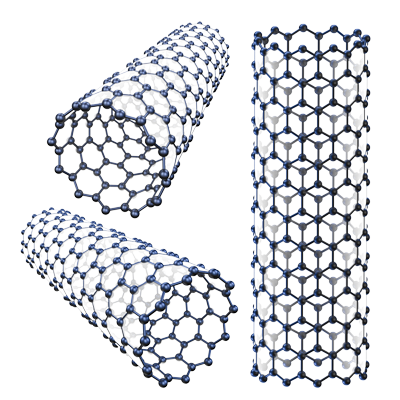_Part of the process (discharging) for electric nanotubes
Due to the interaction of the electrons in the walls between the nanotube shells, the inner core automatically collapses. Their walls as oscillators must have a very high resonance frequency (in GHz)
Researcher and author: Dr. ( Afshin Rashid)
Note: CNTs multi-layered nanotubes present themselves as an ideal material for use in nanoelectronic devices for various reasons. Their walls as their oscillators must have a very high resonance frequency (in GHz) and very high quality factors due to their size and mechanical strength.
It shows a fully atomic hollow layered structure of multi-walled carbon nanotubes that can be used as linear and rotary bearings. Their ability to flex through large angles without breaking means they can also be used for mechanical switches and as hinges. In nanoscale devices, the purpose of which is to use the complete graphical structure of carbon nanotubes. In the electronic conduction of CNTs multilayer nanotubes, the inner core slides independently of the outer walls. The walls exhibit frictionless motion and due to the electron interaction in the walls between the nanotube shells, the inner core collapses automatically.
The strength of carbon-carbon bonds gives carbon nanotubes amazing electronic properties. No previous material exhibits the extraordinary combination of mechanical, thermal and electronic properties attributed to them . However, their conductivity is what sets them apart. Multi-layered carbon nanotubes are the strongest materials that mankind has ever discovered in terms of electronic conductivity. The highest tensile strength or breaking strain for a carbon nanotube was up to 63 GPa, which is about 50 times more than the strongest conductors. Even the weakest types of multi-layered carbon nanotubes have multifold power in electronic conduction. These properties, along with the lightness of carbon nanotubes, give them great potential in applications such as aerospace. The electronic properties of the wall of carbon nanotubes are also extraordinary. It has high electrical conductivity (comparable to copper). It is particularly noteworthy that nanotubes can be metallic or semiconducting.
The rolling action breaks the symmetry of the planar system and imposes a specific direction with respect to the hexagonal grid and the axial direction. Depending on the relationship between these axial directions and the unit vectors that describe the hexagonal lattice, nanotubes may behave electrically like metals or semiconductors, with some nanotubes having higher conductivity than copper, while others They behave more like silicon. And there are capabilities to make nano electronic devices from multi-layer nanotubes of CNTs.
Conclusion :
CNTs multi-layered nanotubes present themselves as an ideal material for use in nanoelectronic devices for various reasons. Their walls as their oscillators must have a very high resonance frequency (in GHz) and very high quality factors due to their size and mechanical strength.
Researcher and author: Dr. ( Afshin Rashid)
Specialized doctorate in nano-microelectronics





